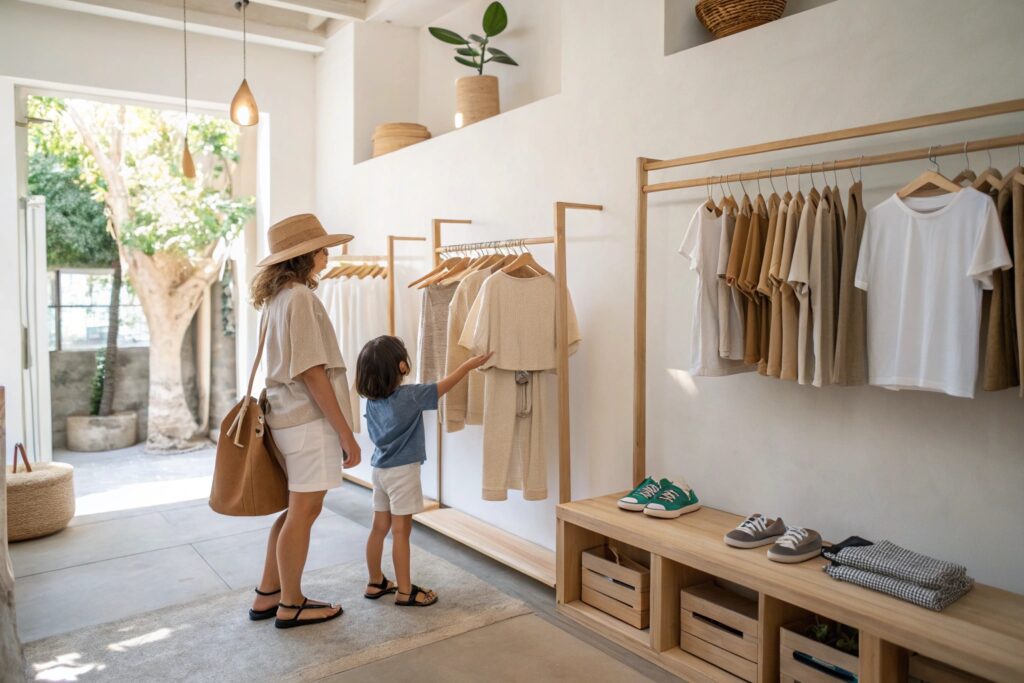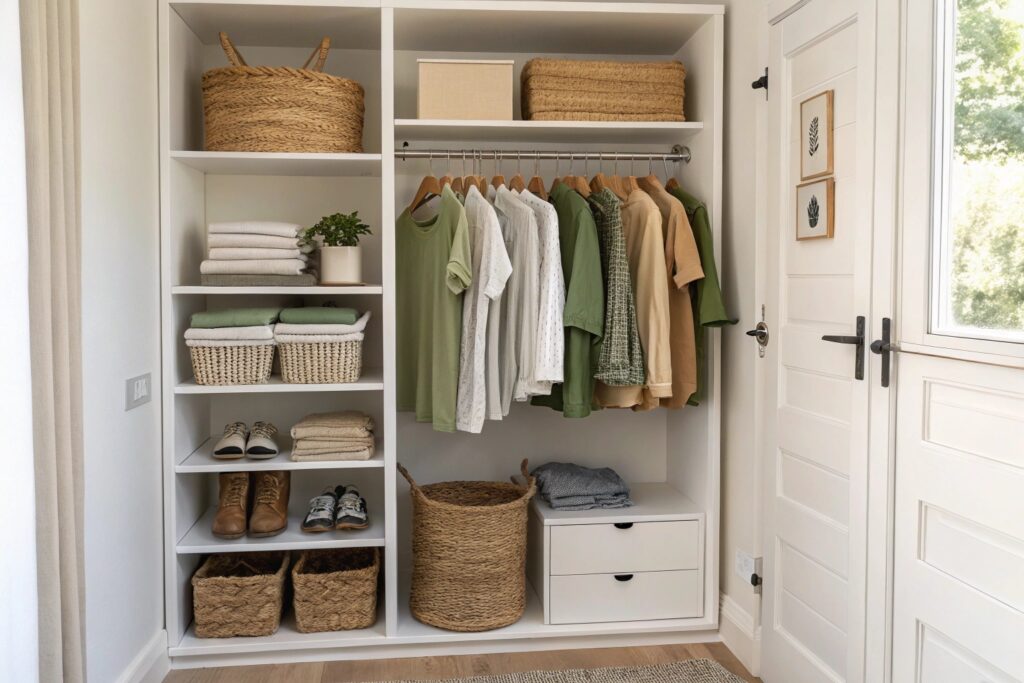If you’re tired of overflowing drawers and unworn outfits that barely last a season, you’re not alone—and neither is the planet.
Eco-minded parents choose capsule wardrobes because they reduce waste, simplify shopping, save money, and support sustainable values through intentional clothing choices.
Capsules aren’t just a parenting hack. They’re a low-impact lifestyle built to support kids and the environment.
Environmental Benefits of Kidswear Capsules
Most kids outgrow clothes faster than they wear them out—but the environmental cost lingers.
Kidswear capsules reduce textile waste, water usage, and carbon emissions by promoting long-term garment use and reducing overproduction.

How do capsule wardrobes lower textile waste compared to traditional kidswear buying?
When parents buy fewer, more durable garments that mix and match, there’s less excess—and less going to landfills. Traditional fast fashion leads to stockpiling clothes that may never be worn. Capsules shift the focus to function and wear frequency.
One of our clients in Canada found that families who adopted their capsule program donated 60% less clothing in a year, because more items were being worn—and worn out. That’s how it should be.
At Fumao Clothing, we design capsule sets to last through growth spurts, multiple washes, and even second owners. That kind of lifespan helps keep garments in rotation—not in the trash.
Why do long-wear garments help lower the carbon footprint of kids’ clothing?
Every garment takes resources to make—water, energy, labor. The longer a single garment is used, the lower its environmental cost per wear.
Here’s a simple example:
| Use Cycles | CO₂ Impact per Use | Total Impact (avg.) |
|---|---|---|
| 3 wears (fast fashion) | High | 5.1 kg CO₂ |
| 15 wears (capsule) | Low | 1.2 kg CO₂ |
We build our capsule collections to hit 20+ wear cycles, meaning less replacement, less shipping, and more value from every garment.
Sustainability isn’t just about recycling—it’s about making fewer, better pieces that last.
How Capsules Help Parents Shop More Sustainably
Sustainable shopping starts with smart planning—not just better products.
Capsule wardrobes encourage sustainable shopping by guiding parents to choose fewer, high-quality, ethically made items instead of bulk-buying low-cost pieces.

How do capsule systems help families avoid impulse purchases and trend-driven waste?
Many parents feel pressure to buy new clothes for every season, trend, or growth stage. But a well-designed capsule removes that pressure. Everything already matches. Everything already fits a purpose.
We helped a retail client introduce capsule bundles for 3 age groups. After launch, customers bought 37% fewer individual items—but satisfaction scores rose. Why? Because parents had what they needed—and nothing they didn’t.
Capsules bring intention into the shopping cart. Less scrolling. Fewer regrets. More value.
What role does product education play in helping parents shop more sustainably?
Most families want to buy better—they just don’t always know how. That’s why we help our B2B partners build educational tools: capsule planning checklists, mixing guides, and age-specific shopping maps.
One U.S. brand we supply added a “Build Your Capsule” quiz to their site. It walks parents through their child’s activities, seasons, and style. Their average order value went up—not from more items, but smarter ones.
Education drives smarter, more sustainable shopping. And once parents try capsules—they rarely go back.
Saving Money and Waste with Minimalist Wardrobes
Capsule wardrobes don’t just save the planet—they save time, money, and closet space.
Minimalist wardrobes reduce clothing waste, lower total spend over time, and increase item usage by focusing on durable, multi-functional pieces.

How do minimalist wardrobes reduce overall clothing spend for growing children?
The average parent buys dozens of clothing items per child each year—but many sit unused. A capsule wardrobe simplifies to just 12–15 key pieces that actually get worn.
Here’s how savings add up:
| Clothing Approach | Avg. Annual Items | Estimated Cost | % Worn Frequently |
|---|---|---|---|
| Traditional Buying | 50+ | $800+ | 20–30% |
| Capsule Wardrobe | 15–18 | $300–400 | 90%+ |
Clients who offer capsule-focused bundles see higher retention rates because customers feel like they’re getting enough without overspending.
At Fumao Clothing, we offer brands multi-use garment styles (e.g., reversible jackets, convertible pants) that further stretch the value of each item.
Why does owning less make room for better use, reuse, and resale?
When each item has a defined role and a quality build, it lasts longer and holds more value in resale or hand-me-down markets.
One of our clients includes a “Next Stop” resale QR label on every kidswear capsule piece. Parents scan it to list the item for trade-in or donation. That creates a loop—clothing stays in use, not storage.
Fewer, better pieces = higher return on each garment.
Eco-Friendly Brands Supporting Capsule Dressing
The capsule movement is growing—and the best brands are leading with both values and design.
Several eco-conscious kidswear brands now focus on capsule collections made from organic, durable materials and designed to reduce waste across multiple wearers.

Which kidswear brands are building capsules that align with sustainable values?
We’ve seen strong growth from the following leaders:
| Brand Name | Specialty Capsule Focus | Sustainability Highlights |
|---|---|---|
| Boden Mini | Pre-styled capsule kits for seasons | Responsible sourcing, durable stitching |
| Quincy Mae | Infant capsules in earth tones | Organic cotton, gender-neutral palettes |
| Jackalo | Adventure-ready wear that’s repairable | Repair program, upcycled materials |
| Primary | Basics that mix & match easily | No-label design, ethical manufacturing |
| Mightly | Playwear capsules built for durability | Fair Trade Certified, family-owned production |
These brands often use Fumao-sourced certified fabrics, especially organic cotton blends and performance finishes designed to survive kid life.
We support brands building circular fashion platforms—capsule designs that are returnable, resellable, and rewearable by design.
How can emerging kidswear brands build their own eco capsule programs?
Start small. Pick 10–12 SKUs that mix-and-match by design. Keep the palette simple. Use fabrics that pass 20+ wear cycles. Offer pre-styled bundles by age group or activity.
At Fumao Clothing, we work with brands from sketch to shelf—offering tech packs, fit samples, and DDP delivery support for capsule launches. We also help set up custom labeling, care instructions, and packaging that tells the capsule story clearly.
Capsule isn’t just a format—it’s a philosophy. And eco-minded parents are already looking for it.
Conclusion
Capsule wardrobes meet eco-minded parenting where it counts: in sustainability, simplicity, savings, and smart design. When done right, they don’t just reduce waste—they build better habits for families and the fashion industry.










